Best Portable Air Compressor For Off Road Adventure (Review)
When you spend a lot of time traveling off-road, maintaining properly inflated tires is even more important for you than the average person. This is especially true if you’re airing down for traction on the trail, and then getting on the highway where underinflated tires are extremely dangerous.
A 12-volt air compressor uses your vehicle electrical system to reinflate the tires.
The best portable air compressors are compact and convenient so that you are more likely to maintain your vehicle. In this article, we’re going to cover features to look for in an air compressor and how to find the best one for your adventure.
- 2.3CFM free flow @ O PSI
- 10.75 pounds
- 60′ total hose length, plus 8′ power cables
- 35-minute duty cycle
- Forty-minute duty cycle
- 20.3 pounds
- 10’ power cord and 24’ coil hose
- Pressure gauge
- 9.9lbs
- 19′ hose, included wiring harness
- All aluminum housing
- Sealed against moisture and dust with IP55 rating
- 2.5 gallon, 200psi air tank
- 3.53 CFM with a 100% duty cycle
- Extreme weather resistance rated at IP67
- 50lb package all installed
Why Do You Need A Portable Air Compressor?
Tires are unsafe if they are underinflated. It seems counter-intuitive, but you are more likely to have a blow-out from an underinflated tire because the sides of your tire are more flexible at lower pressure. This flexing creates heat; heat damages the rubber.
Running quickly down the list, underinflated tires cannot hold as much weight as they are rated for. They are also more likely to cause a rollover during heavy cornering. Poorly inflated RV tires also reduce your fuel efficiency.
Both underinflated tires and overinflated tires will wear unevenly, meaning you’ll have worse traction and be paying for replacement tires sooner. Because full-time travelers rely so much on their vehicles, it is important to be able to keep the tire pressure optimized.
- RV owners
- Travel trailer
- Van life
- Overlanding
- Camping
- Tire inflation
- Load levelers
- Air lockers
- Air tools
- Air tanks
Air compressors can also be used to winterize your RV. Winterizing with air can save you money because purchasing large quantities of anti-freeze can get expensive. Using compressed air is also a faster and more convenient option. Learn how to winterize your RV in this article.
Tire Pressure
At a minimum, you should check your tire pressure at least once a month, and you should always do so before heading out on a long trip.
Tire pressure in SI units is measured as psi (pounds per square inch) and listed as bar in metric applications.
Tire pressure ratings are designed for cold tires, so you should always check in the morning before driving anywhere. Driving and sunshine heat up your tires, which increases the pressure inside the tire–the same way letting a plastic bottle sit in the sun makes it expand.
This is why driving to a gas station to fill your tires is not a great practice. You can air up a really low tire that way, but it won’t get you the most accurate measurement.
Manufacturers take driving and heating up into consideration when rating the tire pressure. If you set your tires to 36psi in the morning, then cruise on the highway and measure again at your next stop, you might see 42psi. This is normal and already accounted for. In this scenario, you should not let air out of your tires!
Since 2007, passenger vehicles in the United States are required to have a tire pressure monitoring system (TPMS). But not all RVs have this feature and most 5th wheels or travel trailers do not. Tire pressure monitoring systems are excellent for safety alerts when driving, especially big rigs where it is harder to see what is going on with all of your tires.
With a TPMS you still need to check tire pressure regularly because most of these devices are only accurate enough to tell you when pressure is extremely low.
How To Check Your Tire Pressure
Personally, we prefer the tried and true inexpensive tire pressure gauge. We have been inconvenienced on too many occasions by failing batteries in digital gauges; but there is no doubt digital gauges are easier to get an accurate reading with.
- Check the tire pressure in the morning before driving.
- Remove the stem cap and line the gauge up with the stem.
- Firmly and quickly press down- you will hear a quick “pst” of air as it is seated, but you should not hear a constant hiss of air. Digital gauges require you to hold down for a second or two.
If you have a lot of wheels like some Class A motorhomes do, you can get an estimate of underinflated tires by using an infrared temperature gun.
Tires that are underinflated will heat up faster than the others around them when driving. Of course, this method is just a quick estimate, and only works after driving for a bit. After finding a problem tire, you can inflate it to what the other tires are sitting at.
How Much Should Tires Be Inflated?
When in doubt, always use the sticker inside the door jam of your vehicle. The cold psi rating will be on a placard inside the driver door or near the entrance door of your 5th wheel.
This tire rating takes into consideration the load on your tires, transaction, handling and ride comfort.
You should not default to inflating to the max psi listed on your tire sidewall; this is harder on your suspension, will cause uneven wear on your treads, and decrease traction.
If you want to get more detail-oriented, look up an “inflation table” for your specific tire brand and size. For this, you will need to weigh your rig at a truck scale and use the weight to check the optimum range listed in this table for that tire.
A final tip: because the dangers of low inflation are more significant, it is better to err on the side of overinflation when maintaining your tires.
Why Use A 12 Volt Compressor?
If you’re going to be acquiring a new tool, you might as well get one that will best perform the job. 12-volt compressors are efficient, compact and reliable. The alternatives to a 12V compressor when camping are:
- Use a standard household/garage AC compressor. These can be plugged into an inverter or campground electricity. They are generally much larger to lug around and a bit less efficient, but if you already have one and the space to store it, free is the best price to pay!
- Use a manual floor pump. It is possible to fill vehicle tires with a good high volume pump, but dang is it a workout and you’ll need second breakfast to make up for the calorie loss.
- Rely on gas stations and garages. This isn’t always convenient, and often you cannot fill your tires properly (we’ll cover that shortly).
Heavy vehicles like 5th wheels and RV travel trailers are more prone to blowouts so it’s even more important to keep their tires properly inflated.
How Are Portable Air Compressors Powered?
Some of the smaller compressors on the market come with a cigarette lighter plug. Because these sockets usually can only provide 5A, they cannot safely power larger compressor motors.
This is why the larger compressors come with two clamps that attach directly to the terminals of your RV battery. They’re then free to power with 25A or more! The only real downside is that you must access your engine compartment or leisure batteries to use it.
Features of Portable Air Compressors
12V Air compressors can be powered with either your car’s cigarette lighter, clamped to your batteries, or hardwired.
Tanked vs Tankless
For general use, compressors with a tank perform better.
They deliver a more constant flow of air, and they allow the motor to cycle off, which is good for longer projects. Tanked air compressors tend to remove more moisture from the air which is good for tools and crafts. Large tanks are also quieter because the motor isn’t running the whole time.
That said, if you’re just using a compressor to inflate tires, there’s little reason to have a tank. Tanks take up a significant amount of space and add unnecessary cost if it’s not being used. For this reason, many adventurers choose a tankless, or small tank for their system.
If you want to use your air system for anything other than inflating tires, we recommend looking at a system with a tank.
Duty Cycle
Air compressors heat up when running so most have a limited consistent output before they need to stop and cool off. This run time in-between cycles is called a duty cycle.
Manufacturers typically represent run time with a number, such as “20”, which means you can run the compressor for 20 minutes every hour. You may also find a percentage that expresses run time (in this case, 33% duty cycle).
PSI
PSI is a measure of how pressurized the air is as it comes out of the compressor. Though you must know the max pressure for your tires, it’s not the most important measurement when buying a portable air compressor.
Most 12V compressors can easily handle the psi needed to inflate tires.
CFM
A more useful metric is cubic feet per minute, or CFM. CFM is a measure of how fast the air can be given to the tire it’s inflating. The higher the CFM, the quicker the device can inflate the tire.
Keep in mind that if an air compressor has a higher CFM, it requires more power, which means a larger profile.
Decibels
You’ll also see a decibel rating when shopping for products, which refers to how much sound the device makes when you use it. 12-volt air compressors are typically quiet; they usually produce about 50-60 decibels.
Because compressors are used infrequently, this is usually a minor consideration for campers, if at all. For some perspective, regular conversations generally are around 65 decibels.
On-Board vs Portable Air Compressors
On-board, or hardwired, compressors are used a lot in overlanding rigs. The benefit is that they are permanently attached when bouncing along the rocks and can usually be tucked away in a convenient spot in your engine compartment or underneath a seat.
On-board air is often used in conjunction with other off road air accessories, such as locking differentials and novelty horns, because they can be kept running while the vehicle is moving.
For most people, portable compressors are the more attractive option. They can be plugged in when needed and are easier to move around to service all of your vehicle tires. They also require no installation, which can get fairly complex with the on-board air compressors.
Power Cord and Air Hose Length
One large difference you will notice in RV specific compressors is the power cord and air hose length. Compressors built for large Class A’s can reach the back tires while still using the battery in the engine compartment. Keep this in mind when buying your compressor, as too much hose takes up more space and is expensive, but necessary for some campers.
Best Portable Air Compressors Reviewed
- 2.3CFM free flow @ O PSI
- 10.75 pounds
- 60′ total hose length, plus 8′ power cables
- 35-minute duty cycle
Best Air Compressor For RV Tires: Viair RV Portable Compressor Kit
Viair produces one of the most recognized portable compressor lines available, and this powerful device has plenty of features that earned it our top pick choice.
Attach the battery clamp to your vehicle’s battery, and it’s ready to deliver up to thirty-five minutes of run time. RV drivers can inflate 35-inch tires from 60 to 80psi in under two minutes per tire. It is a tankless system and comes with an eight-foot power cable, thirty-foot primary air hose and thirty-foot extension air hose to reach all corners of your vehicle.
Additionally, it includes everything you need to get the job done efficiently because it contains a deluxe carry bag, pressure gauge, and inflation gun.
Viair makes a winterization kit that uses the air compressor to winterize your RV!
- 2.3CFM free flow @ O PSI
- 10.75 pounds
- 60′ total hose length, plus 8′ power cables
- 35-minute duty cycle
- Forty-minute duty cycle
- 20.3 pounds
- 10’ power cord and 24’ coil hose
- Pressure gauge
Best Value: Smittybilt 5.65 CFM Universal Air Compressor
Smittybilt makes some very solid products and they have an outstanding no-frills reputation in the off-road community. Their compressors are not only highly dependable, but the price is right, which helped earn it our “Best Value” spot.
For those who need to inflate several tires at once, Smittybilt has designed a product that can do so—all within one duty cycle. Do note that the device may get a bit hot, even when you’re in the cycle, but that won’t affect performance.
The biggest complaint about this unit is the proprietary hose fittings, which make adding accessories an issue unless you customize the hose. Keep in mind, the stock unit may not reach all of the tires on a Class A or Class C without an extension.
- Forty-minute duty cycle
- 20.3 pounds
- 10’ power cord and 24’ coil hose
- Pressure gauge (that’s only sorta accurate)
- 9.9lbs
- 19′ hose, included wiring harness
- All aluminum housing
- Sealed against moisture and dust with IP55 rating
Best Onboard Air System: ARB CKMA12 Air Compressor
This ARB inflator is an off-roading staple because of its compact size and durability. It’s designed to be mounted permanently to your vehicle and can run off-road accessories or inflate your tires. Because of this, it is also great for campers looking to top off a low tire or two with limited space.
This unit is permanently mounted, meaning it will take time to locate and install it properly. Many overlanders put it in the engine compartment or trunk, making sure that the hose can reach all of their tires from where it is mounted. The upside is that it is ready to go whenever you need it!
This 9.9lb unit puts out 3.08CFM. It can inflate four aired-down 35″ in one duty cycle, although in that situation it will take 30 minutes to do so. Topping off a leaky tire is much quicker. ARB is an Australian off-road company that does their due diligence for weather protection, keeping water and dust out of the important bits.
- 9.9lbs
- 19′ hose, included wiring harness
- All aluminum housing
- Sealed against moisture and dust with IP55 rating
ARB also makes a high-performance dual motor 6.16cfm compressor for serious off-roading with larger tires if you plan on frequent heavy use.
- 2.5 gallon, 200psi air tank
- 3.53 CFM with a 100% duty cycle
- Extreme weather resistance rated at IP67
- 50lb package all installed
Best Onboard 12V Air Compressor For Tools: VIAIR Dual 444C Onboard Air System
If you are planning on running air tools and want a purpose built on-board vehicle system, VIAIR shines the brightest. They have almost too many options to chose from.
The go-to recommendation for us, sight unseen, is the Dual 444C OBA. This is a dual compressor system that pumps out 3.53cfm and can reach a working pressure of 200psi.
They do make less expensive versions, but the dual compressor setup is really needed to constantly run air tools, especially with the relatively small 2.5 gallon air tank that are built in with these. Trying to run an air impact on a single compressor will leave you wanting, and if you’re going to permanently mount a compressor in your rig, you might as well do it right.
- 2.5 gallon, 200psi air tank
- 3.53 cfm with a 100% duty cycle
- Extreme weather resistance rated at IP67
- 50lb package all installed
That’s A Wrap!
A portable tire inflator is your first line of defense against the problems that low tire pressure can cause, especially when the nearest gas station is miles away.
Whatever your budget, there’s a product to meet your needs. If you want a great all-around value pick, we recommend the Smittybilt option. If you’re looking for something built to a more specific vehicle application, ARB and Viair are both excellent choices. We wouldn’t hesitate to recommend any of these brands for reliability.
And remember, even the best portable tire inflator is useless if it stays packed away. Be vigilant about checking your tire pressure to ensure you and your family’s safety on the road.

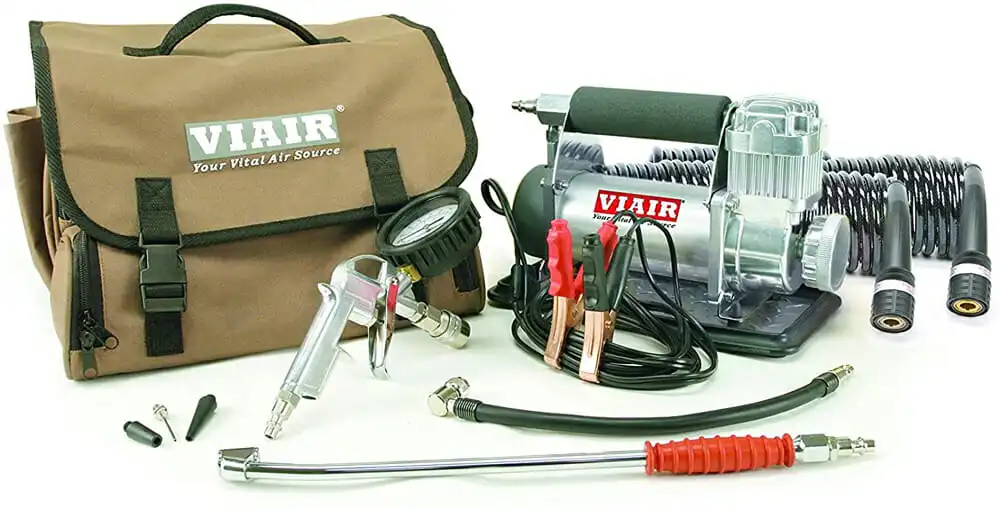
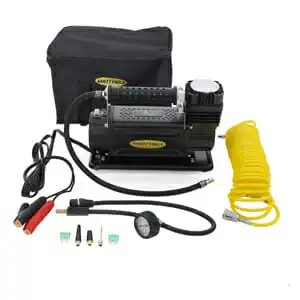
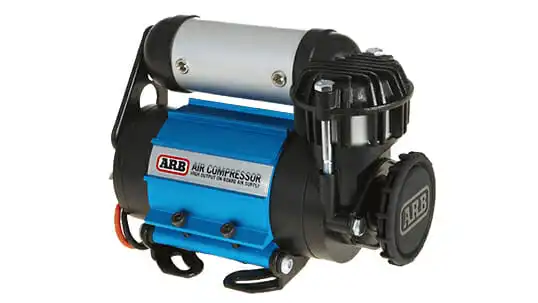
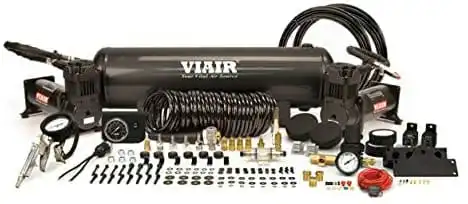
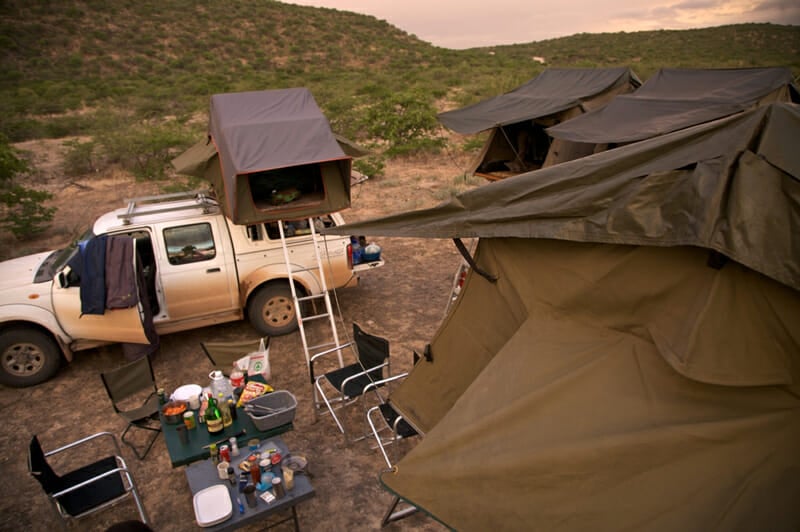
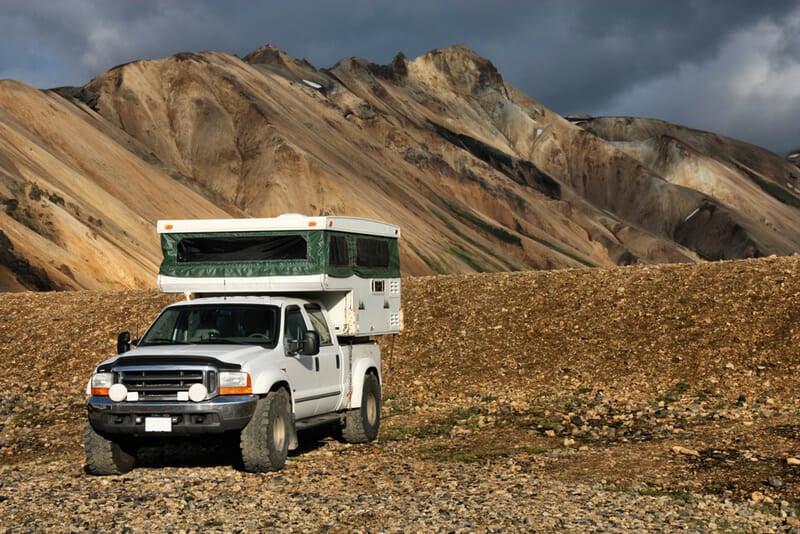
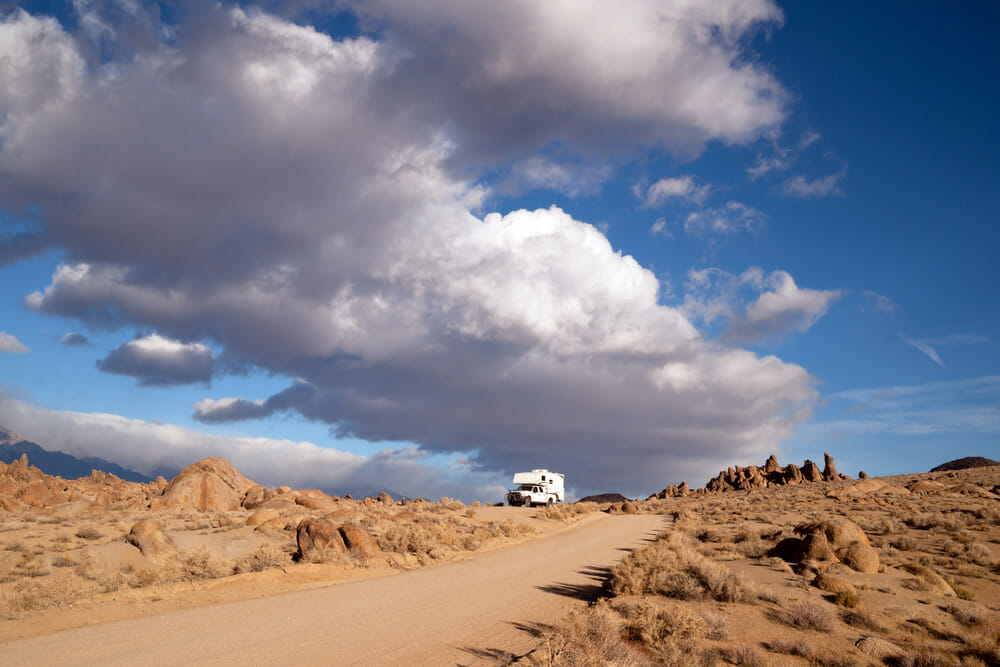

20 minutes per hour is not the same as a 20% duty cycle – 20 minutes would be 20/60, or 33%.
Good catch! I’ve just gone in and updated the article. Thank you!
What size air compressor do I need to inflate RV tires?
Hi! Thanks for this list of portable air compressors. I’m looking to buy one for my jeep. I have the VIAIR and Smittybilt on my cart but I haven’t checked out yet because I can’t decide which of them to buy. Good thing I was able to read your reviews on these products.
I use VIAIR to air up LT and RV tires to 80psi while on road trips. Works great, is fast and the combined length of the power cord and two air hoses allow me to tire of a 35 foot fifth wheel with no problems. Compressor shuts off automatically, allowing you to air tires a long distance from it without having to manually cut it off. This is the best compressor I have owned. It is pricey, but I firmly believe you get what you pay for.